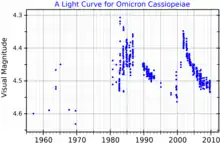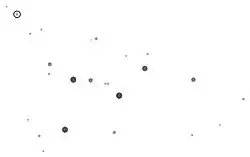Omicron Cassiopeiae
Omicron Cassiopeiae (ο Cas, ο Cassiopeiae) is a triple star system in the constellation Cassiopeia. It is approximately 700 light-years from Earth, based on its parallax.[1] It is visible to the naked eye with a slightly variable apparent magnitude of about 4.5.

| Observation data Epoch J2000.0 Equinox J2000.0 | |
|---|---|
| Constellation | Cassiopeia |
| Right ascension | 00h 44m 43.51867s[1] |
| Declination | +48° 17′ 03.7136″[1] |
| Apparent magnitude (V) | 4.30 - 4.62[2] |
| Characteristics | |
| Spectral type | B2-5III-Ve(shell)[2] |
| U−B color index | −0.53[3] |
| B−V color index | −0.06[3] |
| Variable type | γ Cas[2] |
| Astrometry | |
| Radial velocity (Rv) | −12.36 ± 0.41[4] km/s |
| Proper motion (μ) | RA: 18.84[5] mas/yr Dec.: -7.18[5] mas/yr |
| Parallax (π) | 4.7046 ± 0.4306 mas[5] |
| Distance | 690 ± 60 ly (210 ± 20 pc) |
| Absolute magnitude (MV) | −2.55 / 0.35[4] |
| Orbit[4] | |
| Primary | ο Cas Aa |
| Companion | ο Cas Ab |
| Period (P) | 1031.55 d |
| Semi-major axis (a) | 0.0170 ± 0.0006″ |
| Eccentricity (e) | 0 |
| Inclination (i) | 115.0 ± 2.6° |
| Longitude of the node (Ω) | 267.3 ± 0.8° |
| Periastron epoch (T) | JD 2452792.2 ± 0.6 |
| Argument of periastron (ω) (secondary) | 0° |
| Semi-amplitude (K1) (primary) | 21.593 ± 0.071 km/s |
| Details[4] | |
| ο Cas Aa | |
| Mass | 6.2 M☉ |
| Radius | 8.0 R☉ |
| Temperature | 14,000 K |
| Rotational velocity (v sin i) | 220 km/s |
| ο Cas Ab | |
| Mass | ~5 M☉ |
| Other designations | |
| Database references | |
| SIMBAD | ο Cas A |
| ο Cas B | |
The primary component, ο Cassiopeiae A, is a spectroscopic binary, and its close companion completes one orbit every 2.83 years (1,031.55 days). The system has also been resolved with interferometry.[4]
The primary of this spectroscopic binary is a blue-white B-type giant star.[6] It is classified as a Gamma Cassiopeiae variable and its brightness varies from magnitude 4.30 to 4.62. It is rotating at a speed of 375 km/s at its equator (close to its theoretical break-up velocity of 390 km/s), although because the pole is inclined 36 degrees, its projected rotational velocity is only 220 km/s.[4] The nature of the secondary is not well known. Despite the fact that the secondary is 2.9 magnitudes dimmer than the primary, the secondary appears to have a mass similar to, or even larger than primary.[4] It is possible that the secondary is a pair of early A-type main-sequence stars.[4]
A more distant companion, ο Cassiopeiae B, lies 33.6 arcseconds away. It is an eleventh-magnitude, F-type main-sequence star.[6] Because it has a similar proper motion to the central system, it is assumed to be gravitationally bound.[7]
References
- van Leeuwen, Floor (13 August 2007). "Validation of the new Hipparcos reduction". Astronomy & Astrophysics. 474 (2): 653–664. arXiv:0708.1752. Bibcode:2007A&A...474..653V. doi:10.1051/0004-6361:20078357. eISSN 1432-0746. ISSN 0004-6361.
- Samus, N. N.; Durlevich, O. V.; et al. (2009). "VizieR Online Data Catalog: General Catalogue of Variable Stars (Samus+ 2007-2013)". VizieR On-line Data Catalog: B/GCVS. Originally Published in: 2009yCat....102025S. 1. Bibcode:2009yCat....102025S.
- Johnson, H. L. (1966). "UBVRIJKL Photometry of the Bright Stars". Communications of the Lunar and Planetary Laboratory. 4: 99. Bibcode:1966CoLPL...4...99J.
- Koubský, P.; Hummel, C. A.; Harmanec, P.; Tycner, C.; Van Leeuwen, F.; Yang, S.; Šlechta, M.; Božić, H.; Zavala, R. T.; Ruždjak, D.; Sudar, D. (2010). "Properties and nature of Be stars". Astronomy and Astrophysics. 517: A24. Bibcode:2010A&A...517A..24K. doi:10.1051/0004-6361/201014477.
- Brown, A. G. A.; et al. (Gaia collaboration) (August 2018). "Gaia Data Release 2: Summary of the contents and survey properties". Astronomy & Astrophysics. 616. A1. arXiv:1804.09365. Bibcode:2018A&A...616A...1G. doi:10.1051/0004-6361/201833051. Gaia DR2 record for this source at VizieR.
- Koubský, Pavel; Ak, Hasan; Harmanec, Petr; Yang, Stephenson; Božić, Hrvoje (2004). "The Be star omicron Cassiopeiae". IAU Colloq. 193: Variable Stars in the Local Group. 310: 387. Bibcode:2004ASPC..310..387K.
- Pourbaix, D.; et al. (2004). "SB9: The ninth catalogue of spectroscopic binary orbits". Astronomy and Astrophysics. 424 (2): 727–732. arXiv:astro-ph/0406573. Bibcode:2004A&A...424..727P. doi:10.1051/0004-6361:20041213. S2CID 119387088.
